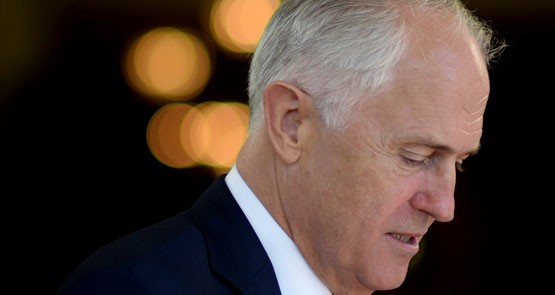
A few short weeks after Malcolm Turnbull publicly foreshadowed an election to be held on the usual timetable between August and October, a sudden change in the government’s tune is prompting fevered speculation that the nation’s seventh double dissolution election will be held at the start of July.
The first sign something was up appeared a fortnight ago, when the government made it known that it planned to have Senate reform legislation through Parliament by the end of the autumn session, with the Greens and Nick Xenophon providing the required numbers if Labor refused to play ball.
The proposal as reported would remove the biggest obstacle to a double dissolution by abolishing group voting tickets, which promised to be a bonanza for micro-parties if applied to a full Senate election with 12 vacancies per state.
However, the smaller parties are to be thrown a bone through a requirement that above-the-line voters must number at least six boxes. This is in contrast to last year’s cross-party proposal by the Joint Standing Committee on Electoral Matters, which would have let voters number a single party’s box and have their preferences go no further — something the overwhelming majority of voters choose to do when given the option in elections for the New South Wales Legislative Council.
The pot was given a further stir on Tuesday by outgoing Nationals leader Warren Truss, who called for the government to clean out the Senate by going to a double dissolution on July 2.
This notion can certainly be credited with a boldness that hasn’t otherwise been much in evidence from the Turnbull government so far.
Nonetheless, the difficulties that caused some of us to argue that a double dissolution was unlikely to occur haven’t gone away.
One big headache for the government is the budget, which is due to be brought down one day before the May 11 cut-off date for calling a double dissolution.
The timetable outlined in Chris Uhlmann’s report on ABC television last night assumed it would be tenable to ram the budget through both houses of Parliament in one day and bring on the double dissolution the next, which may reflect an overly sanguine view on the part of Uhlmann’s sources.
The only other option would be to postpone the budget until after the election, and have the Senate pass an interim supply bill so the wheels of government would kept turning into the new financial year.
That would effectively give the Senate an opportunity to veto the double dissolution by refusing to pass the bill.
Such a course would certainly appeal to the small party senators elected in 2013, who would otherwise find their cherished six-year terms cut in half.
It’s less clear if both Labor and the Greens would find it in their interests to shirk the contest in this way — or to assume the mantle of Malcolm Fraser by blocking a supply bill.
Another worry for the government is the exhausting, long campaign that would result from calling an election on May 11 for July 2.
The reason July is important to the government is that the newly elected Senate’s term would be backdated to the middle of last year if it were held any earlier. There would then need to be a half-Senate election barely two years later, with the government of the time all but obliged to bring the two houses’ cycles back into line by holding an early House of Representatives election at the same time.
The only way around that is to make it through to July with a campaign period of around eight weeks — nearly twice as long as governments have generally favoured since the 10-week marathon that preceded Bob Hawke’s first re-election bid in 1984.
That election is a particularly inauspicious precedent for Malcolm Turnbull, as it resulted in a prime minister with stratospheric approval ratings being run unexpectedly close by an opposition leader — in this case Andrew Peacock — who had previously struggled to make a mark.
Should the government think the risk worth taking, the Australian Electoral Commission — which had quite enough trouble in the more settled circumstances of 2013 — would have barely three months in which to reprogram its election counting software, develop new counting procedures, revisit staffing arrangements, and conduct a massive publicity campaign to educate the public about the new system.
Of particular concern is the burden of data entry in the absence of electronic counting. Until now, data entry has only been required for below-the-line votes, of which there were around half a million at the 2013 election. But if above-the-line voters are required to number six boxes rather than just one, sequences for all ballot papers — perhaps as many as 14 million of them — will have to be entered into the system.
This could be even worse than it sounds, as electoral administrators report there is no longer a large casual workforce available with the requisite data entry skills, which technological developments have largely rendered obsolete.
There is also the issue of how voters would cope with a new set of instructions on Senate ballot papers after three decades of familiarity with the existing regime.
Here again we can invoke the distant memory of the 1984 election, which was the last time the Senate voting was reupholstered, in that case through the introduction of above-the-line voting.
Labor laid much of the blame for its disappointing result on a tripling in the informal vote, as many voters took the Senate ballot paper’s directive to number one box only as applying to the House of Representatives as well — a misunderstanding that disproportionately affected Labor’s low-income and immigrant base.
The biggest danger this time around is that voters will ignore the fine print and continue numbering one box above the line, as they have been doing for over three decades, and may continue to do in state upper house elections everywhere except Queensland and Tasmania.
According to one report, the responsible minister, Matthias Cormann, is considering dealing with the issue by allowing group voting tickets to co-exist with the new option of multiple boxes numbered above the line, even though this would go a long way towards defeating the main purpose of the reforms.
All of which ultimately demonstrates that Senate electoral reform is beset at every level by challenges and complications, not all of which will have been properly thought through by its proponents.
Given its fundamental importance to the way we are governed, it deserves better than the parliamentary rush job that a government fixated on short-term tactical advantage appears to have in mind for it.








Abbott did to much stupid stuff. Turnbull does nothing stupidly.
“…there is no longer a large casual workforce available with the requisite data entry skills [to transcribe a sequence of six numbers], which technological developments have largely rendered obsolete.” Do they need to enter the data in Morse code? Or is interpreting handwritten numbers considered an obsolete skill?
The problem seems to me to be entirely self-inflicted. Quite why we persist with our impossibly complicated Senate voting system escapes me. The committee that is looking at possible changes seems to have an extremely limited brief.
Why not adopt a proportional voting system? The voter simply puts a cross beside the party of their choice. If they get 50% of the vote, that party gets 50% of the available seats, knowing in advance who will be elected because the party (as now) has candidates listed in order of the party’s preference.
Having a 5% threshold (as in Germany and New Zealand for example) excludes the lunatic fringe with minimal real support.
At a stroke you have done away with “preference whisperers”, people getting elected with less than 1% of the vote; the need for complicated counting software etc etc.
Too innovative and agile for a political class that is not interested in real reform and never will be.
I know they want to use the proposed legislation now, but it’s more reasonable to use it for the following election. Trying to modify the software in this short a timeframe is dangerous.
Why is the Senate vote “reform” not offering the option of numbering a reasonable minimum number of boxes below the Line? Never mind the beachtowel ballot paper – there are only 6 places on offer (apart from the NT & ACT)so make it double that.
JO’N – have I misunderstood that you suggest party voting? Look what that gave us in 2004!